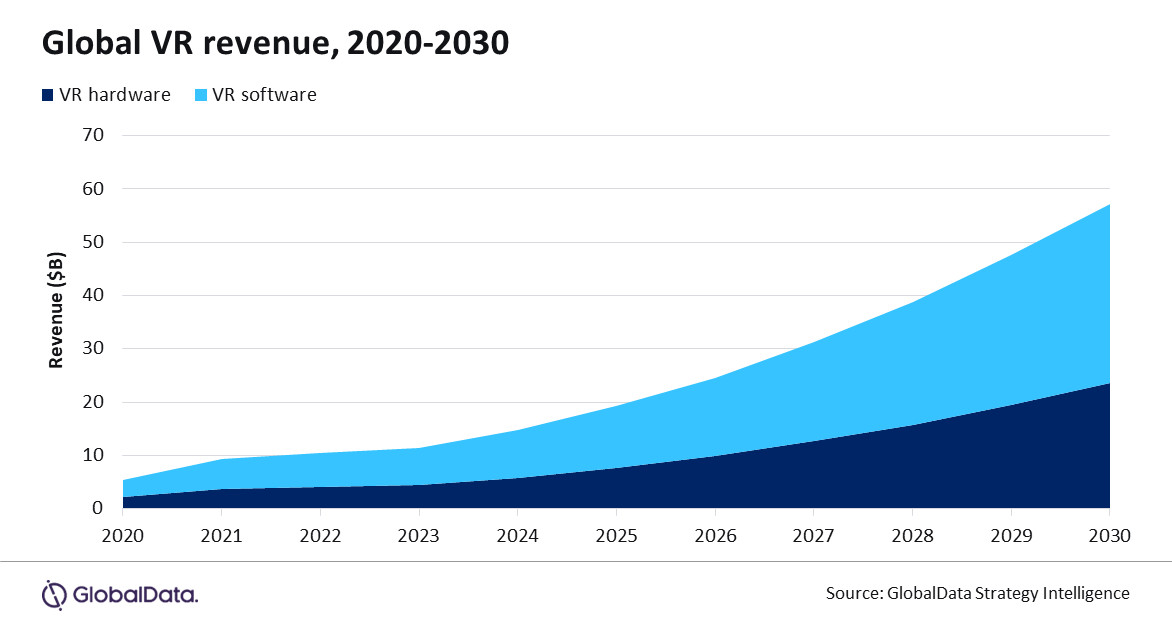How the Virtual Reality Market’s Journey to a $57Bn Valuation by 2030 Will Reshape the Training Worldwide


In Brief
GlobalData predicts a 26% CAGR growth in the global VR industry, reaching $57 billion by 2030, despite potential barriers to mainstream acceptance.

The worldwide VR industry is expected to rise greatly, from $11 billion in 2023 to $57 billion by 2030, despite obstacles that might hinder mainstream acceptance, according to latest predictions from GlobalData. This expansion amounts to a 26% compound annual growth rate (CAGR) for this time frame. Stakeholders in this changing landscape must comprehend the dynamics of this expansion, the reasons impacting it, and the difficulties that lie ahead.
Market Dynamics: Software and Hardware Growth
Numerous reasons, including technological developments, declining prices, and changing customer tastes, are driving the expansion of the virtual reality industry. According to GlobalData’s Strategic Intelligence research, the revenue proportion of VR hardware is predicted to rise from 39% to 41%, while the revenue share of VR software is predicted to significantly decrease from 61% in 2023 to 59% in 2030. This change reflects a greater focus on hardware as VR becomes more widely available.

The production of increasingly immersive experiences and advancements in content creation technologies are driving the growing demand for VR software. Users are expected to get increasingly involved with VR as developers improve the applications’ quality and engagement. Furthermore, it is anticipated that the decrease in VR headset hardware costs would draw in more customers and promote broader adoption.
Mixed Reality’s Ascent
The shift to mixed reality (MR), a hybrid technology that incorporates virtual items into the actual world, is an intriguing trend in the VR space. As they want to broaden their product lines, VR hardware makers are finding this change to be more and more alluring. After first concentrating just on VR headsets, companies including HTC, Meta, and Pico have begun to look at MR solutions. For example, HTC’s Vive Focus 3, which debuted in 2022, is a stand-alone MR headset, while Meta is working on adding MR functionality to its lineup of headsets.
This tendency is best shown by Apple’s Vision Pro, which is expected to debut in early 2024 and shows how the industry may go toward MR technology. Opportunities in a number of industries, including design, education, and healthcare, are presented by MR’s capacity to merge digital and real surroundings. Overlapping digital features onto the physical environment can improve user experiences and processes in various domains, increasing engagement.
Overcoming Adoption Obstacles
Even if the VR industry is expected to increase, there are still a number of obstacles that might stop it. The price of VR headsets, which normally run from $200 to $1,000, is one of the biggest obstacles. Many potential users may not be able to afford the high-performance equipment required, particularly for tethered headsets.
Another area of research is health issues associated with extended VR use. Motion sickness, headaches, and eye strain are among the problems users have experienced, which may discourage potential consumers. These health issues need to be resolved through better user experience and design if VR is to succeed in the long run. This might entail creating more comfortable and lightweight headsets and improving software to lessen user pain.
An Essential Component of the Content Ecosystem
The creation of engaging and varied virtual reality material is essential to the technology’s success. Even while several noteworthy VR experiences have captured audiences’ attention, building a strong content ecosystem that regularly produces top-notch experiences is still difficult. The lack of a wide variety of uses and experiences may restrict VR technology’s attractiveness and impede its development.
Content producers need to concentrate on creating captivating experiences that appeal to users if they want the VR business to flourish. This entails investigating a range of genres, from entertainment and gaming to instruction and training. There is a greater chance of establishing a thriving ecosystem as more developers venture into the virtual reality arena and try out creative material.
Stakeholder Strategic Considerations
The worldwide VR industry is expected to reach a worth of $57 billion by 2030, therefore players need to be on the lookout and adjust to the shifting conditions. Businesses that produce VR software and devices should carefully think through their approaches. To take advantage of new prospects, some may decide to concentrate on improving VR skills, while others may decide to switch to MR.
Businesses will need to spend money on research and development in order to provide novel products that satisfy consumers’ changing wants. Additionally, collaborations with developers and content producers may support the expansion of a varied content ecosystem, guaranteeing that consumers will have access to engaging experiences.
Virtual Reality’s Future
The worldwide virtual reality market forecast points to a bright future marked by substantial expansion and innovation. Although there are issues with cost, health, and content creation, technological developments and changing customer tastes offer a positive environment for the sector.
Stakeholders must continue to take the initiative to solve these issues as VR technology develops and take advantage of chances to reach a wider audience. The shift to mixed reality might also be crucial in determining how the VR industry develops in the future by providing fresh opportunities for expansion and interaction.
In conclusion, cooperation, creativity, and a deep comprehension of market dynamics will be necessary to reach the $57 billion worldwide VR industry by 2030. Realizing the full potential of virtual reality technology will depend on the industry’s continued commitment to developing immersive experiences and breaking down obstacles.
Disclaimer
In line with the Trust Project guidelines, please note that the information provided on this page is not intended to be and should not be interpreted as legal, tax, investment, financial, or any other form of advice. It is important to only invest what you can afford to lose and to seek independent financial advice if you have any doubts. For further information, we suggest referring to the terms and conditions as well as the help and support pages provided by the issuer or advertiser. MetaversePost is committed to accurate, unbiased reporting, but market conditions are subject to change without notice.
About The Author
Victoria is a writer on a variety of technology topics including Web3.0, AI and cryptocurrencies. Her extensive experience allows her to write insightful articles for the wider audience.
More articles

Victoria is a writer on a variety of technology topics including Web3.0, AI and cryptocurrencies. Her extensive experience allows her to write insightful articles for the wider audience.

















































